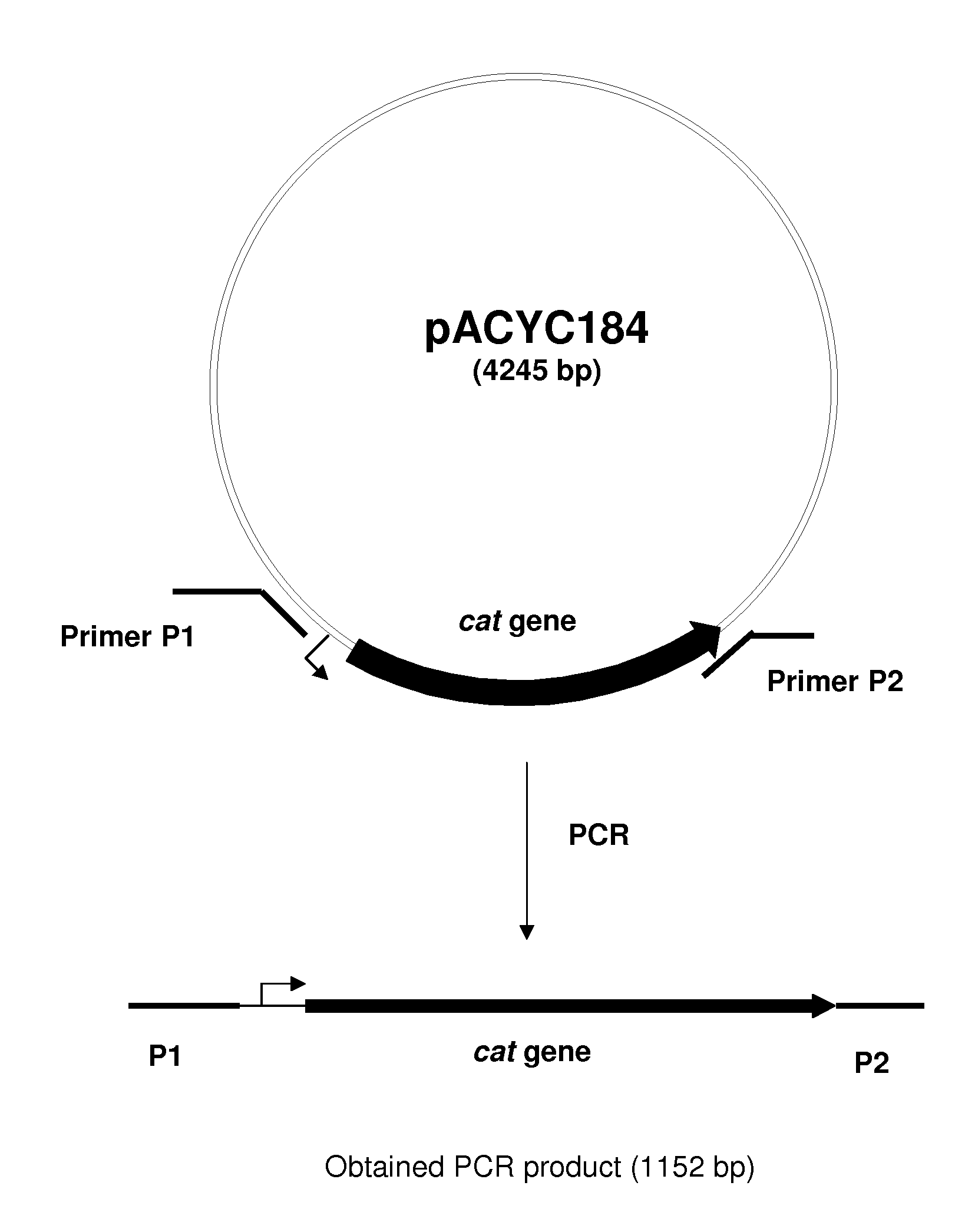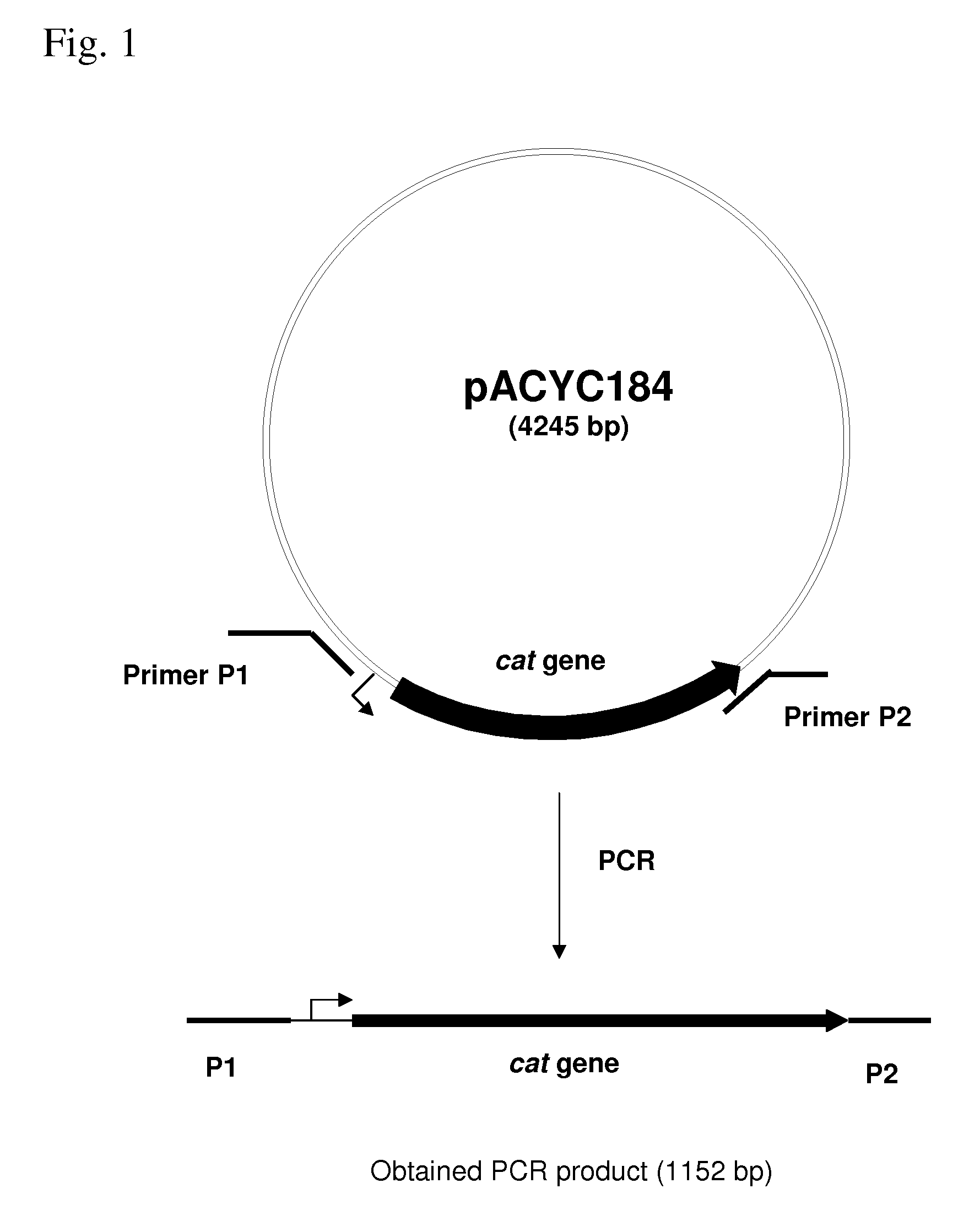METHOD FOR PRODUCING AN L-AMINO ACID USING A BACTERIUM OF THE ENTEROBACTERIACEAE FAMILY WITH ATTENUATED EXPRESSION OF THE rspAB OPERON
a technology of enterobacteriaceae and operon, which is applied in the field of microorganisms, can solve the problems of no reports of attenuation of expression, and achieve the effect of enhancing the productivity of l-amino acid-producing strains
- Summary
- Abstract
- Description
- Claims
- Application Information
AI Technical Summary
Benefits of technology
Problems solved by technology
Method used
Image
Examples
example 1
Construction of a Strain with an Inactivated rspAB Operon
[0124]1. Deletion of the rspAB Operon.
[0125]The rspAB operon was deleted by the method initially developed by Datsenko, K. A. and Wanner, B. L. (Proc. Natl. Acad. Sci. USA, 2000, 97(12), 6640-6645) called “Red-driven integration”. According to this procedure, the PCR primers P1 (SEQ ID NO: 5) and P2 (SEQ ID NO: 6), which are complementary to both the region adjacent to the rspAB operon and the gene conferring antibiotic resistance in the template plasmid, were constructed. The plasmid pACYC184 (NBL Gene Sciences Ltd., UK) (GenBank / EMBL accession number X06403) was used as a template in the PCR reaction. Conditions for PCR were as follows: denaturation step: 3 min at 95° C.; profile for two first cycles: 1 min at 95° C., 30 sec at 50° C., 40 sec at 72° C.; profile for the last 25 cycles: 30 sec at 95° C., 30 sec at 54° C., 40 sec at 72° C.; final step: 5 min at 72° C.
[0126]An 1152 bp PCR product (FIG. 1) was obtained and purifi...
example 2
Production of L-threonine by E. coli strain B-3996-ΔrspAB
[0130]To test the effect of inactivation of the rspAB operon on threonine production, DNA fragments from the chromosome of the above-described E. coli MG1655 ΔrspAB::cat were transferred to the threonine-producing E. coli strain VKPM B-3996 by P1 transduction (Miller, J. H. Experiments in Molecular Genetics, Cold Spring Harbor Lab. Press, 1972, Plainview, N.Y.) to obtain the strain B-3996-ΔrspAB. The strain B-3996 was deposited on Nov. 19, 1987 in the All-Union Scientific Center of Antibiotics (Russia, 117105 Moscow, Nagatinskaya Street, 3-A) under the accession number RIA 1867. The strain was also deposited in the Russian National Collection of Industrial Microorganisms (VKPM) (Russia, 117545 Moscow, 1 Dorozhny proezd, 1) under the accession number VKPM B-3996.
[0131]Both E. coli B-3996 and B-3996-ΔrspAB, were grown for 18-24 hours at 37° C. on L-agar plates. To obtain a seed culture, the strains were grown on a rotary shaker ...
example 3
Production of L-lysine by E. coli AJ11442-ΔrspAB
[0135]To test the effect of inactivation of the rspAB operon on lysine production, DNA fragments from the chromosome of the above-described E. coli strain MG1655 ΔrspAB::cat can be transferred to the lysine-producing E. coli strain AJ11442 by P1 transduction (Miller, J. H. Experiments in Molecular Genetics, Cold Spring Harbor Lab. Press, 1972, Plainview, N.Y.) to obtain the AJ11442-ΔrspAB strain. The strain AJ14442 was deposited at the National Institute of Bioscience and Human-Technology, Agency of Industrial Science and Technology (currently National Institute of Advanced Industrial Science and Technology, International Patent Organism Depositary, Tsukuba Central 6, 1-1, Higashi 1-Chome, Tsukuba-shi, Ibaraki-ken, 305-8566, Japan) on May 1, 1981 and received an accession number of FERM P-5084. Then, it was converted to an international deposit under the provisions of the Budapest Treaty on Oct. 29, 1987, and received an accession numb...
PUM
| Property | Measurement | Unit |
|---|---|---|
| temperature | aaaaa | aaaaa |
| temperature | aaaaa | aaaaa |
| pH | aaaaa | aaaaa |
Abstract
Description
Claims
Application Information
 Login to View More
Login to View More - R&D
- Intellectual Property
- Life Sciences
- Materials
- Tech Scout
- Unparalleled Data Quality
- Higher Quality Content
- 60% Fewer Hallucinations
Browse by: Latest US Patents, China's latest patents, Technical Efficacy Thesaurus, Application Domain, Technology Topic, Popular Technical Reports.
© 2025 PatSnap. All rights reserved.Legal|Privacy policy|Modern Slavery Act Transparency Statement|Sitemap|About US| Contact US: help@patsnap.com



